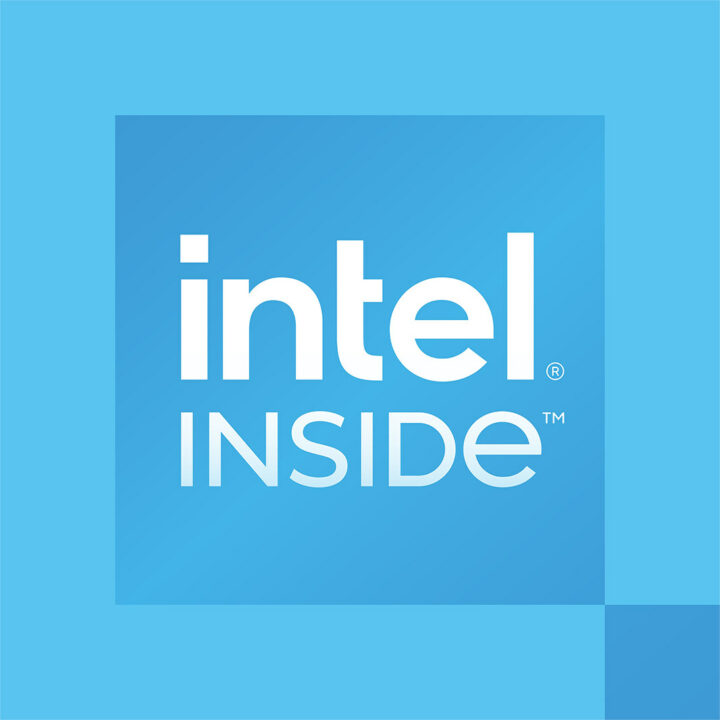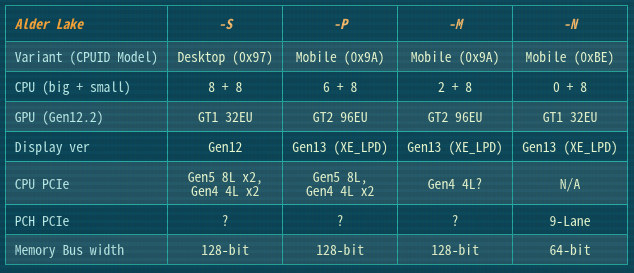Intel recently announced they would kill the Celeron and Pentium brands for entry-level PCs, and replace these with the “Intel Processor” brand for notebooks from 2023 onwards, meaning we would get “Intel Core” and “Intel Processor” processors depending on the market segment.
The Intel N100 & N200, or more exactly the Intel Processor N100 and Processor N200, Alder Lake-N SKUs may be the first chips with the new branding. They were discovered by Coelacanth-Dream while looking at some Linux boot logs.
Intel Processor N100:
|
1 2 3 4 |
<6>[ 0.000000] DMI: Intel Corporation Alder Lake Client Platform/AlderLake-N LP5 RVP, BIOS ADLNFWI1.R00.3301.A00.2207190854 07/19/2022 <6>[ 0.000000] tsc: Detected 800.000 MHz processor <6>[ 0.324882] smpboot: CPU0: Intel(R) N100 (family: 0x6, model: 0xbe, stepping: 0x0) <6>[ 0.335923] smp: Brought up 1 node, 4 CPUs |
Intel Processor N200:
|
1 2 3 4 |
<6>[ 0.000000] DMI: Intel Corporation Alder Lake Client Platform/AlderLake-N LP5 RVP, BIOS ADLNFWI1.R00.3301.A00.2207190854 07/19/2022 <6>[ 0.000000] tsc: Detected 1000.000 MHz processor <6>[ 0.319625] smpboot: CPU0: Intel(R) N200 (family: 0x6, model: 0xbe, stepping: 0x0) <6>[ 0.430132] smp: Brought up 1 node, 4 CPUs |
Both processors appear pretty similar but the boot logs show the N100 with an 800 MHz base frequency, and the N200 with a 1,000 MHz base frequency. Coelacanth-Dream further analyzed the data and found extra information about the Alder Lake-N processors as shown in the table below.
The new SKUs will not feature “big” Performance cores at all, and only be offered with up to eight “small” Efficiency cores, up to 32EU GT1 graphics, a 9-lane PCIe PCH, and a narrower 64-bit memory bus while the other Alder Lake families all sport a 128-bit memory bus. We’ll need to wait for an official announcement or more leaks to get additional details about the new parts.
While Intel has decided to do without Pentium and Celeron for notebooks, they may remain for IoT products, as I remember Intel killed the Atom brand for consumer-grade processors, but it is still used in some industrial processors. I personally find the new “Intel Processor” brand confusing, but Intel says the change was made to “streamline the brand architecture” and “simplify the purchasing experience”:
With this new, streamlined brand architecture, Intel will continue to sharpen its focus on its flagship brands: Intel Core, Intel Evo and Intel vPro. In addition, this update streamlines brand offerings across PC segments to enable and enhance Intel customer communication on each product’s value proposition, while simplifying the purchasing experience for customers.
About Intel Processor: Intel Processor will serve as the brand name for multiple processor families, helping to simplify the product purchase experience for consumers. Intel will continue to deliver the same products and benefits within segments. The brand leaves unchanged Intel’s current product offerings and Intel’s product roadmap.
The good news is they won’t rename Pentium and Celeron processors that have already been released!
Via Wccftech

Jean-Luc started CNX Software in 2010 as a part-time endeavor, before quitting his job as a software engineering manager, and starting to write daily news, and reviews full time later in 2011.
Support CNX Software! Donate via cryptocurrencies, become a Patron on Patreon, or purchase goods on Amazon or Aliexpress. We also use affiliate links in articles to earn commissions if you make a purchase after clicking on those links.






Ah, I’ve always wanted me some Intel Intel Processor processors!
It’s clearly a Big Brain(TM) marketing-move: making you repeat the words multiple times will make it harder to forget them and soon enough you will forget every other word ever existed!
Oh it will likely lead to even funnier discussions:
followed by ”Intel’s ‘Intel Pro-Processor’™ processor processors generations”🄯 ?
(memory bus width 128bit, from Risc-V example?)
> Which model ?
N100 or N200?
IIRC there were no duplicate model names with their stupid Celeron/Pentium branding. A N5000 is an older ‘Pentium Silver’ but the similarly named newer N5105 is a ‘Celeron’ while the N6000 is the same generation Pentium Silver differing only by faster clockspeeds. The ‘Pentium Gold’ thingies were different beasts with much better memory and single-threaded performance.
The low-end stuff (pentium, celeron with N5xxx etc) are extremely confusing and when you want to buy a machine with such a name advertised on it, you have no other option but go to ark to figure what generation it is, how many cores it has etc. It’s a total mess. I’m sure they’re having people in charge of that segment who are just not wired like normal people and find it normal to go back and forth between numbers in different product ranges and generations. But confusion doesn’t help to sell, it scares customers away, making them fear they’re about to make the wrong choice.
I’ve not heard of Evo before. When did that come about? Also, vPro is a brand, now? I thought it was a bullet point feature for their business focused products!
> I’ve not heard of Evo before. When did that come about?
~2 years ago. To receive the Evo badge a laptop must not be that crappy as the average Windows laptop. It’s about decent battery life, full performance while on battery, non-shitty Wi-Fi, TB4 ports, USB-C charging and whatever else that makes them similar to MacBooks wrt pricing and functionality. 😉
next Intel marketing move? INTEL’s iP™ (Intel7, 10ESF node) processors?
(maybe it’s just about who’s presenting that/a new identity change for being conciliated before (‘peevish’ about) all luxury of subsequent efforts?)
So, this is a thicker Ultrabook kind of thing? Thanks for the info, I was totally not aware of that product branding from Intel. Googling shows they’ve been at it for a while. I was recently in the laptop market and I don’t recall ever seeing this branding. Maybe I missed it. I’ll go review.
Oh, so nothing about having useable keyboards? 🙂
Having had a day to reflect on this, I think I’ve realized that Evo just means “what laptops were before Intel pushed everyone to their Thin and Light Ultrabooks”. Like the old beast that I’m currently typing on. It can run all cores at max clocks forever, had plenty of I/O, etc. It well predates USB-C, so it’s not got that, but maybe someone makes a ExpressCard to USB-C adapter? 🙂
> Like the old beast that I’m currently typing on. It can run all cores at max clocks forever
How many hours on battery? That was more the point. I’ve seen fellow network consultants failing so many times when doing measurements with their Windows laptops since on battery the whole system magically slowed down. Also the requirements for non-crappy Wi-Fi, TB4 ports and USB-C charging have nothing to do with form factor…
[ hardware: depends on location? of ‘this’™ www, software: sorry™ ]
Intel hired Steve Ballmer.
https://www.youtube.com/watch?v=KMU0tzLwhbE
Now sing the song:
Intel Intel Processor Processors,
Intel Intel Processor Processors,
Intel Intel Processor Processors,
Intel Intel Processor Processors,
..
It looks like another N chip is in hiding, if both the N100 and N200 have 4 cores. The 8-cores have yet to be revealed.
If they were going to make the branding as generic as possible, why not lump them all under N1xx? Oh well, we’ll see what happens.
The 8-core models should be called Core i3-N305 and Core i3-N300
https://www.cnx-software.com/2022/02/11/low-power-alder-lake-n-processors-coming-to-chromebooks-embedded-systems/#comment-598570
Geekbench’s comparison mode can be used to check cache sizes and Processor ID as well. The latter missing in individual results but there at least in N305’s case base and boost clockspeeds can be found: 1.8/3.8 GHz. For N200 the boost clock is reported as 0GHz.
And the scores are as suspicious as always with Geekbench: N200 has a single-threaded AES-XTS score of 97.3% compared to N305 but multi-threaded the quad-core outperforms the octa-core by 135.6%.
We develop the R86S Mini pc series from J1900 to N5100/N5105 then we upgrade them to the N6005 series. But now we plan to try Intel N100 & N200 Alder Lake-N for a new design. That will be a Mini PC box that support all Alder Lake-N CPU including Intel® Core™ i3-N305 8C, 15W (cTDP 9W), 3.8/3.0 GHz Intel® UHD Graphics 32EUs 1250 MHzIntel® Core™ i3-N300 8C, 7W, 3.8/2.6 GHz Intel® UHD Graphics 32EUs 1250 MHzWe are expecting the performance for such low-power chips.
AAEON is selling a pricey Intel Customer Reference Board for Alder Lake-N processors but without any CPU that needs to be purchased directly from Intel.
https://eshop.aaeon.com/intel-alder-lake-customer-reference-board-adlsktcrbmtr-ckd-preorder.html